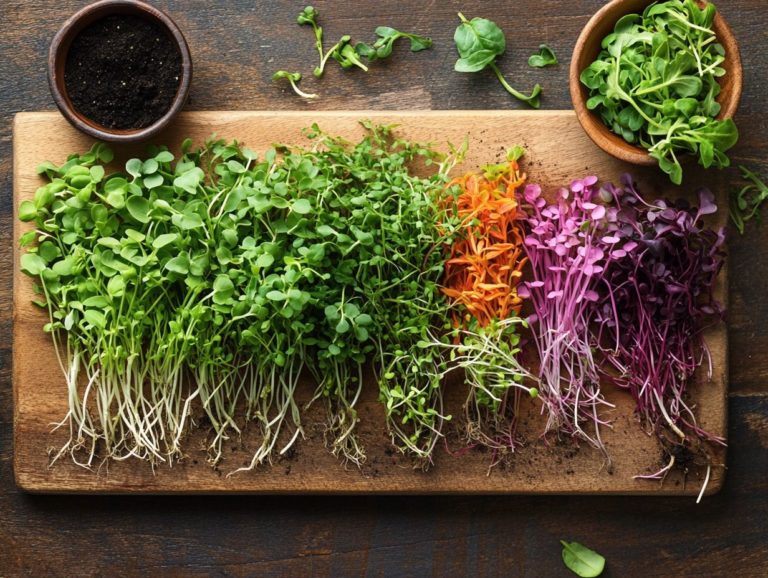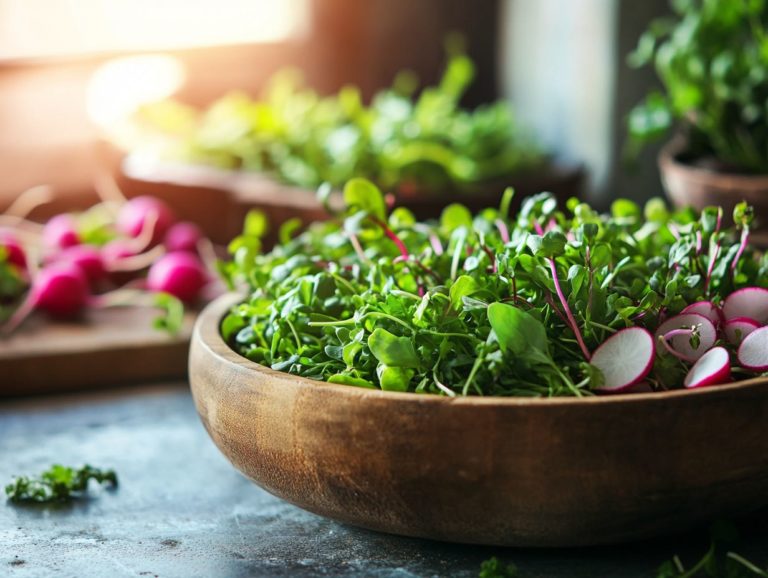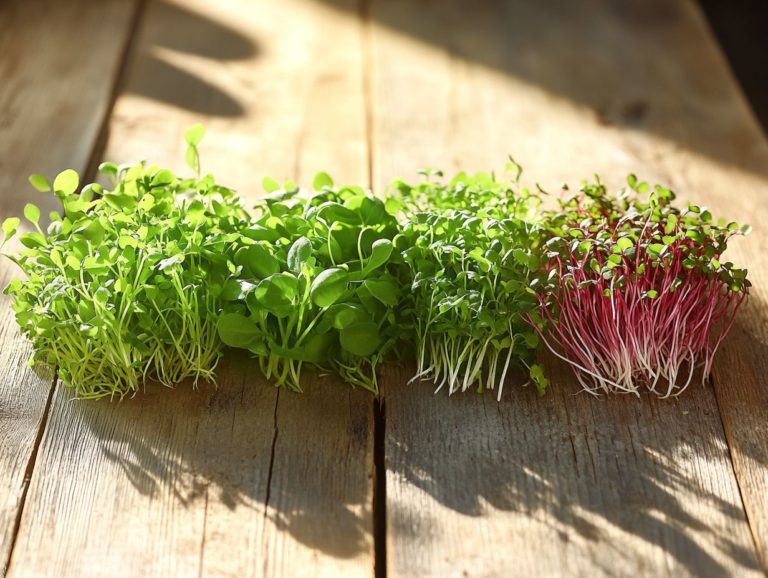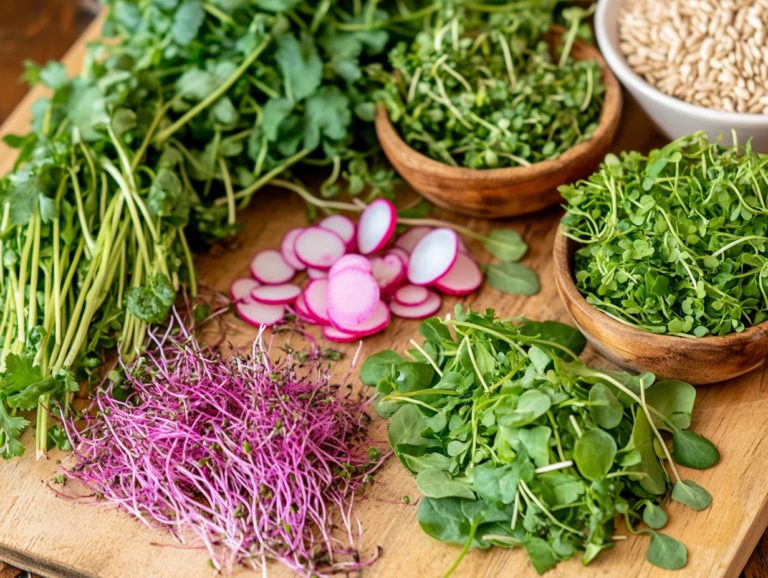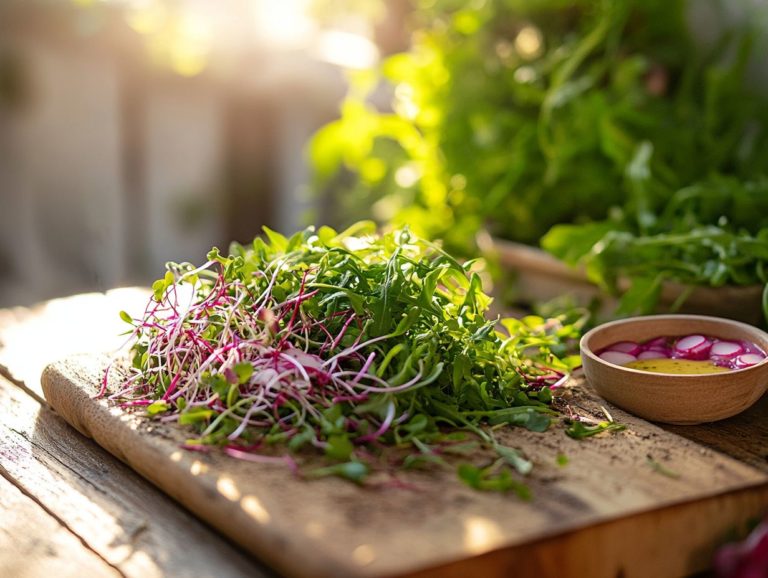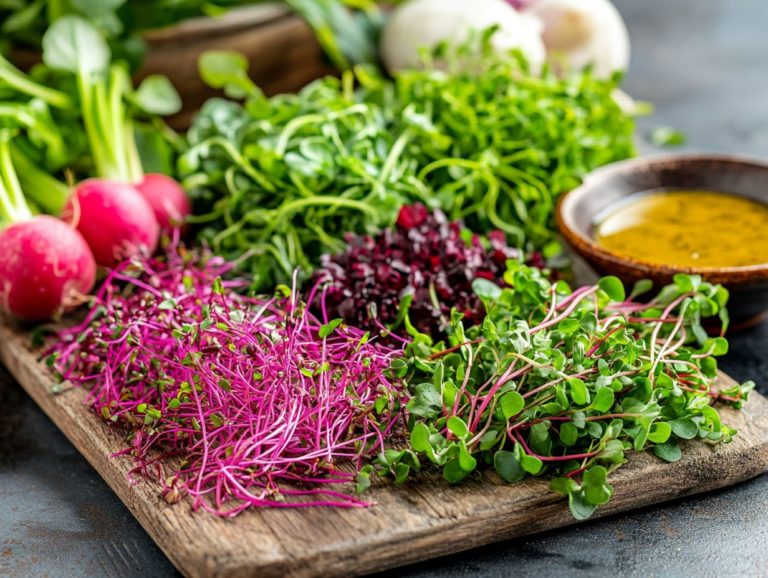The Health Benefits of Colorful Microgreens
Microgreens are not merely a trendy garnish; they deliver a remarkable nutritional boost that you won’t want to miss, making them a true superfood.
These small greens, harvested just after the first leaves emerge, come in a delightful variety and offer impressive health benefits. With their rich antioxidant properties and potential to reduce the risk of chronic diseases long-lasting conditions that can be managed but not cured microgreens truly deserve a spot in your diet.
This article explores the different types of microgreens, highlights their nutritional advantages over mature plants, and provides practical cooking tips for incorporating them into your meals.
You will also find a guide on how to grow your own microgreens right at home!
Contents
- Key Takeaways:
- What are Microgreens?
- Nutritional Benefits of Microgreens
- Health Benefits of Eating Microgreens
- How to Incorporate Microgreens into Your Diet
- Growing Your Own Microgreens
- Frequently Asked Questions
- What are microgreens?
- What are the health benefits of colorful microgreens and their nutritional value?
- How do colorful microgreens compare to their mature counterparts in terms of nutrition and dietary fiber?
- Do all microgreens have health benefits?
- Are there any specific health benefits associated with different colored microgreens?
- How can I incorporate colorful microgreens into my diet and cooking recommendations?
Key Takeaways:
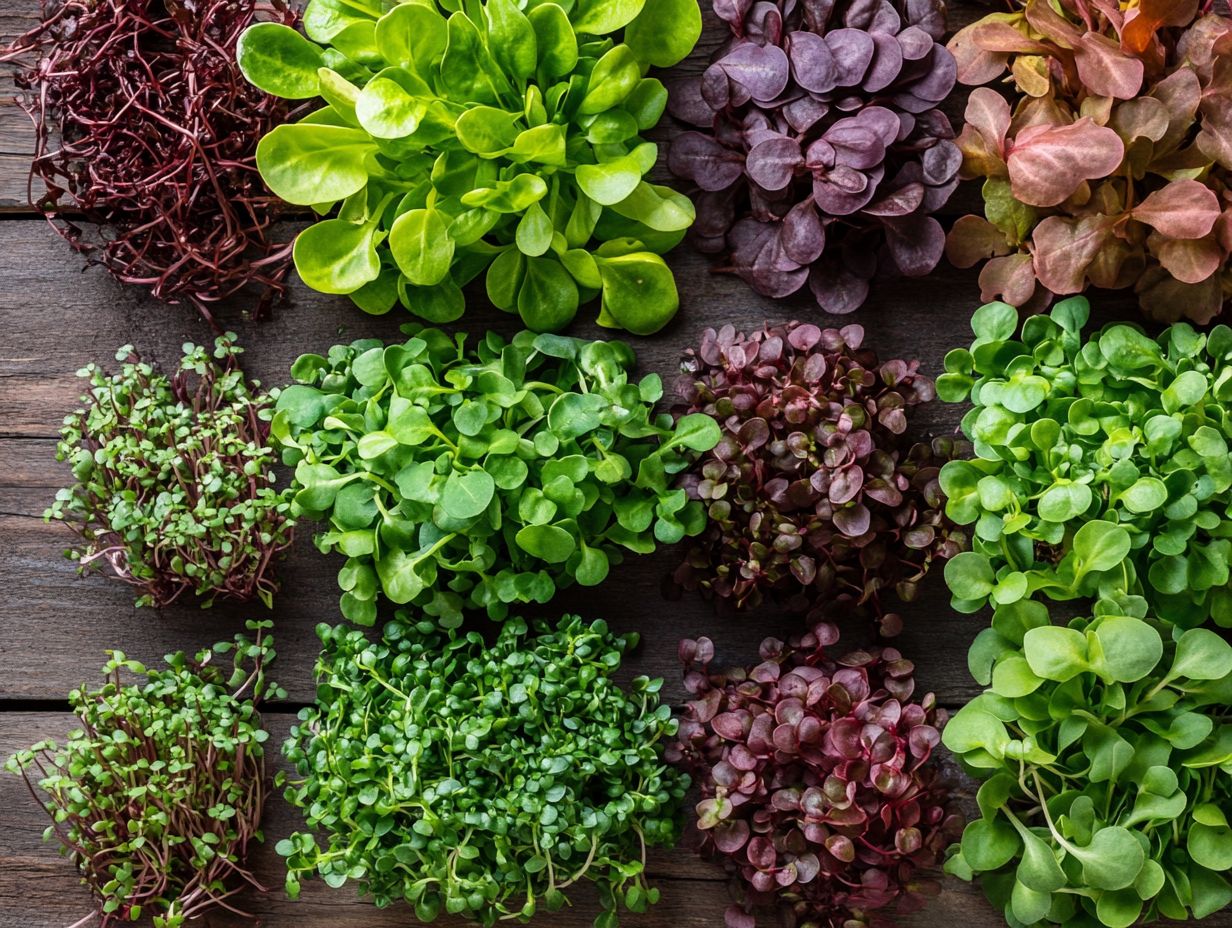
- Microgreens are young, nutrient-dense plants that offer a burst of flavor and color to any dish.
- Compared to mature plants, microgreens contain higher concentrations of essential vitamins, minerals, and antioxidants, including potassium and iron.
- Including microgreens in your diet can help boost your immune system and decrease your risk of chronic diseases, while adding a vibrant touch to your meals.
What are Microgreens?
Microgreens are young, nutrient-packed plants harvested shortly after their first true leaves emerge, usually within 7 to 21 days post-germination.
These vibrant and aromatic greens think broccoli, spinach, and kale have garnered significant attention for their impressive nutritional benefits and health-enhancing properties, contributing to their reputation as nutrient-dense foods. Integrating them into your diet is a savvy choice for daily nutrition.
Their petite size and high water content not only elevate the visual appeal of your dishes but also introduce a distinctive flavor profile along with a treasure trove of vitamins and minerals.
Definition and Types
Microgreens are the young seedlings of edible vegetables and herbs, harvested just as they unfurl their first true leaves.
These little wonders provide a concentrated source of vitamins and minerals, especially vitamins A, C, and K, that can elevate any dish.
Among the most celebrated varieties are broccoli, kale, and Brussels sprouts microgreens, each bringing its own unique textures and tastes to the table.
Take broccoli microgreens, for instance. They offer a mild, slightly peppery flavor that makes them an ideal garnish for salads or sandwiches. Kale microgreens, with their delicate and subtly sweet taste, are perfect for enhancing smoothies, grain bowls, and other healthful options. Additionally, understanding the role of microgreens in healthy eating can help you incorporate these nutrient-packed greens into your diet.
And let’s not forget Brussels sprouts microgreens, which lend a nutty essence that enhances everything from soups to pizzas, showcasing their remarkable versatility in the kitchen.
Nutritional Benefits of Microgreens
The nutritional benefits of microgreens are truly remarkable, positioning them as a powerhouse of health-enhancing nutrients.
You ll find that they often boast higher concentrations of vitamins, minerals, and antioxidants when compared to their mature counterparts.
Comparison to Mature Plants

When you compare microgreens to their mature plant counterparts, you’ll find that these tiny greens pack a remarkable nutritional value in a smaller serving size, boasting higher levels of vitamins, antioxidants, and beneficial nutrients.
Take vitamins like C and K, for example; microgreens contain these in significantly higher concentrations. In fact, some varieties can deliver up to five times more vitamin C than fully grown plants.
The impressive array of antioxidants in microgreens offers enhanced protection against oxidative stress, promoting your overall health.
While mature plants certainly provide valuable dietary fiber, microgreens can often serve as a more concentrated source of essential nutrients, making them a fantastic addition to your meals.
The health benefits are substantial incorporating these vibrant greens can bolster everything from your immune system to bone strength.
Health Benefits of Eating Microgreens
Indulging in microgreens provides you with an array of health benefits. Their abundant antioxidant content enhances disease prevention, while their elevated levels of essential vitamins bolster your overall wellness, as shown in various research studies.
Embracing these nutrient-packed greens can truly elevate your health journey!
Antioxidant Properties
Microgreens are celebrated for their impressive antioxidant content, which plays a vital role in fighting oxidative stress, a process that can harm your cells, potentially reducing your risk of chronic illnesses like cancer.
Research reveals that these petite powerhouses are brimming with vitamins E, C, and A, alongside a variety of polyphenols and beneficial nutrients, all of which enhance their health benefits. Studies indicate that incorporating microgreens into your diet can significantly boost antioxidant levels in your body, helping to neutralize those pesky free radicals. For more detailed information, you can explore the health benefits of microgreens explained, which also contributes to cancer research.
For example, a study published in the Journal of Agricultural and Food Chemistry found that specific microgreens, such as broccoli and radish, exhibited antioxidant capacities that outshine their mature counterparts. This surge in antioxidants not only elevates your overall health but also offers protective effects against diseases associated with oxidative stress, including heart disease and certain neurodegenerative disorders. To learn more about these benefits, check out why microgreens are superfoods you need.
Reduced Risk of Chronic Diseases
Incorporating microgreens into your diet may significantly reduce your risk of chronic diseases, including heart disease and diabetes, by positively influencing your blood pressure and cholesterol levels.
Research demonstrates that these plants rich in nutrients are bursting with vitamins, minerals, and antioxidants, all of which can profoundly impact your cardiovascular health. Regularly consuming microgreens, particularly the top microgreen varieties for health enthusiasts, may help you manage cholesterol by lowering LDL, also known as ‘bad cholesterol,’ which can harm your heart health. Their high fiber content enhances digestive health and supports gut health, which is closely linked to heart health.
Certain microgreens are also rich in potassium, a mineral that plays a crucial role in regulating blood pressure, potentially aiding you in maintaining a healthy cardiovascular profile. By integrating these vibrant greens into your daily meals, including options from the top 10 microgreens for nutritional boost, you can take a practical step toward enhancing your diet and improving cholesterol levels while mitigating the risks associated with chronic illnesses.
How to Incorporate Microgreens into Your Diet

Adding microgreens to your meals is easy and fun! They elevate your dishes with fresh produce, delivering a delightful burst of flavor and a vibrant vegetable confetti that enhances the visual appeal of your meals.
Recipes and Serving Suggestions
Microgreen recipes can elevate your culinary experience, ranging from simple salads to elaborate dishes, whether you choose to enjoy them raw or as an elegant garnish that enhances both flavor and nutrition.
Imagine sprinkling them atop creamy avocado toast for that perfect crunch and a pop of color! Soups, too, can come alive with a handful of microgreens stirred in just before serving, adding a lively finish that delights the palate. To learn more about their benefits, check out the science behind microgreens and health.
Using microgreens as a garnish on fish or meats not only enhances the presentation but also transforms an ordinary plate into a gourmet experience. Their versatility makes them an exciting ingredient for everything from casual meals to special occasions.
Growing Your Own Microgreens
Cultivating your own microgreens offers a gratifying and sustainable approach to enjoying fresh produce right in your home. The beauty of it lies in the simplicity these little powerhouses are remarkably easy to grow, whether you choose to nurture them indoors or outdoors!
Don’t miss out on these amazing health benefits! Start your journey with microgreens today!
Tips and Techniques for Cultivation
To successfully cultivate homegrown microgreens, you can use several growing tips and techniques that guarantee the best yield and flavor from your plants. This makes them ideal for kids gardening and sustainable food practices.
Focus on key components such as soil selection, proper watering practices, optimal light exposure, and effective harvesting techniques. These will help you create the perfect environment for vibrant greens to flourish. Choosing the right soil is essential. Opting for a fine seed-starting mix or organic potting soil will enhance drainage and nutrient availability, ensuring your microgreens thrive.
Regular watering is essential. Be careful to avoid overwatering, as too much moisture can invite mold and reduce the quality of your healthy foods. For light, place your microgreens near a sunny window or use grow lights for 12-16 hours each day to significantly accelerate their growth.
When it comes time to harvest, do so at the right moment typically when the first true leaves emerge. This ensures you enjoy the best taste and nutritional value from your crops, maximizing their health-supporting components.
Frequently Asked Questions
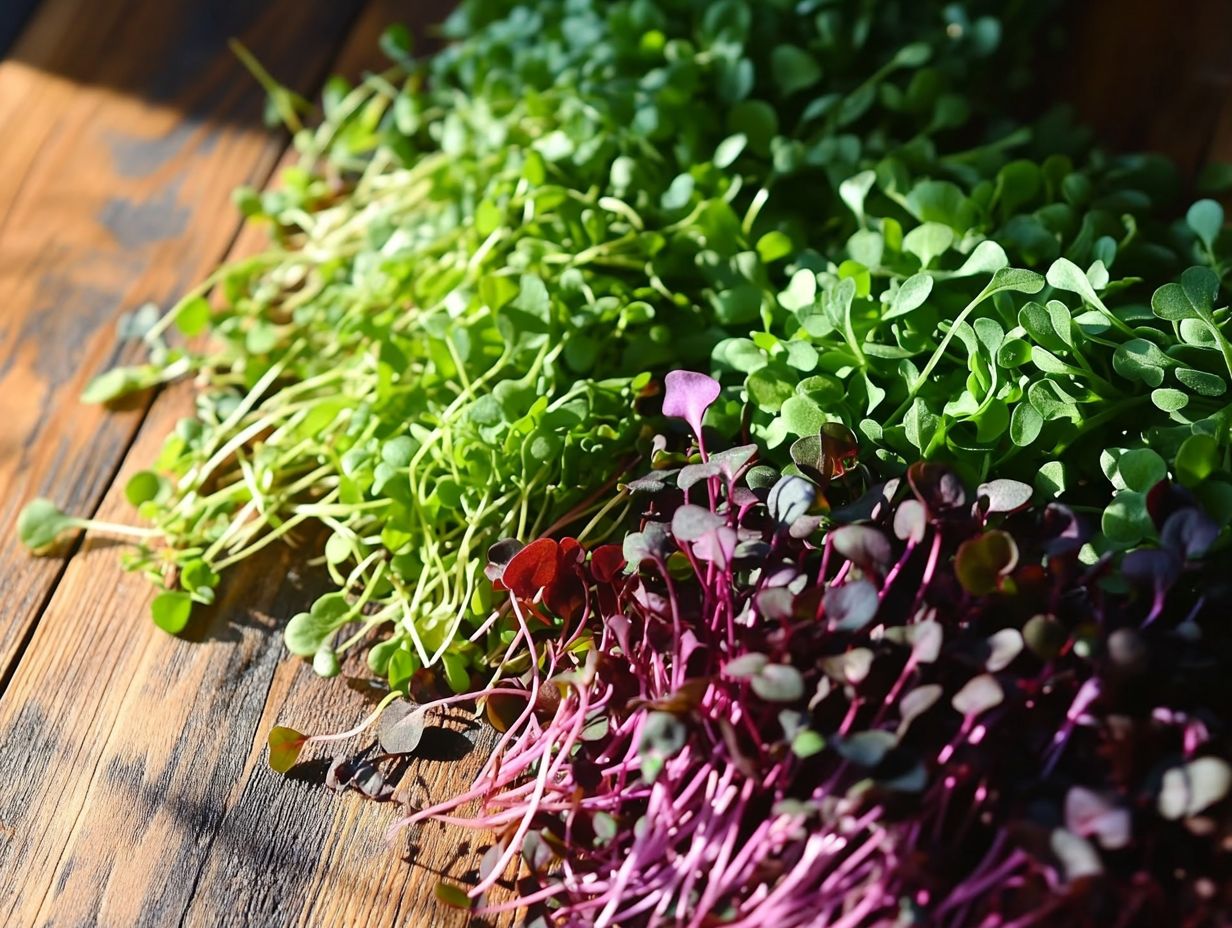
What are microgreens?
Microgreens are tender seedlings of vegetables and herbs packed with flavor and various colors. They are known for their healthful greens and superfood status.
These young vegetable greens are harvested after the sprouting stage and just before the true leaves form. Their vibrant colors and intense flavors make them popular in the culinary world, particularly due to unlocking the antioxidant power of microgreens.
What are the health benefits of colorful microgreens and their nutritional value?
Colorful microgreens are packed with vitamins, minerals, and antioxidants, making them a nutritious addition to any diet. They have been linked to improved digestion, immune system function, and heart health, among other benefits.
How do colorful microgreens compare to their mature counterparts in terms of nutrition and dietary fiber?
Incredible news! Microgreens can pack up to 40 times more nutrients than mature plants. They are harvested at such an early stage that their nutrient content is at its peak.
Do all microgreens have health benefits?
While all microgreens are nutritious, colorful microgreens tend to have higher levels of certain beneficial compounds. These include carotenoids pigments found in plants that benefit your health and anthocyanins, which are responsible for their vibrant colors.
Are there any specific health benefits associated with different colored microgreens?
Yes, the different colors of microgreens indicate the presence of various phytochemicals, which have unique health benefits. For example, red and purple microgreens contain high levels of anthocyanins, which can help reduce inflammation and promote heart health.
How can I incorporate colorful microgreens into my diet and cooking recommendations?
Colorful microgreens can be added to salads, sandwiches, smoothies, soups, and many other dishes. They add a burst of flavor and nutrition and are excellent for garnishing dishes, making them more visually appealing.
Why not start growing your own microgreens today? They re fun and easy!
What microgreens have you tried growing? Share your tips below!

